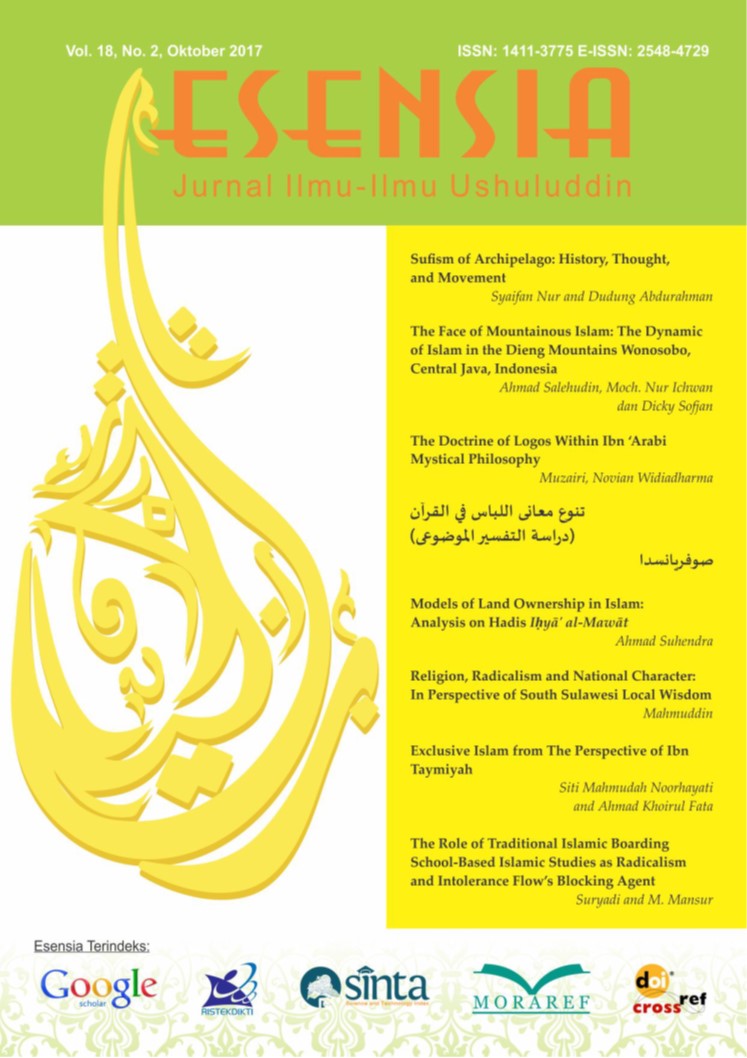The Doctrine of Logos Within Ibn ‘Arabi Mystical Philosophy
Main Article Content
Abstract
There are no less than twenty-two terms which Ibn ‘Arabi uses to designate what one might call a Mohammedan Logos. References to these terms, with explanations, will be given later. The reason, why we find Ibn‘Arabi using such a large collection of terms for one thing, is twofold. In the first place, it is due to the fact that he derived his material from so many divergent sources, preserving, so far as possible, the terminology of each source. Here, e.g., he is using terms borrowed from Sufis, scholastic theologians, Neo-platonists, the Qur’an and so on. Secondly, his pantheism enables him to use the name of anything for the One Reality which is the ultimate ground of all things. The terms to below refer to different aspects of the One Reality which is now regarded as the Logos.
[Tidak kurang dari sekitar 22 istilah yang digunakan oleh Ibn ‘Arabi untuk merujuk apa yang disebut sebagai “logos Muhammad”. Beberapa referensi bagi istilah tersebut dengan penjelasannya akan dijelaskan berikutnya. Terdapat dua alasan utama yang menjadikan Ibn ‘Araby menggunakan puluhan istilah untuk menyebut hal yang sama. Pertama, dikarenakan adanya fakta bahwa ia mengambil seluruh material dari berbagai macam sumber dan sebisa mungkin mempertahankan istilah dari masing-masing sumber. Dalam hal ini, ia meminjam istilah dari kelompok sufi, teolog skolastik, neo-platonis, al-Qur ’an dan yang lainnya. Kedua, panteisme-nya memungkinkan untuk memakai beragam nama sesuatu bagi satu realitas yang menjadi pusat dari segala sesuatu. Istilah-istilah yang begitu banyak merupakan aspek-aspek yang berbeda dari Realitas Yang Satu yang kini dipandang sebagai Logos.]
Article Details
References
Affifi, A.E. The Mystical Philosophy of Muhyid Din Ibnu ‘Arabi. Cambridge: at the University Press, 1939.
Al-Fayyadl, Muhammad. Derrida, Yogyakarta: LKIS, 2012.
Ali, Yansrin. Manusia Citra Ilahi. Jakarta: Paramadina, 1997.
Almond, Philip C. Mystical Experience and Religious Doctrine. New York: Wakter de Gruter and co, 1992.
Angeles, Peter A. Dictionary of Philosophy. London: Barnes & Noble Books, 1977.
Arberry, A.J. Sufism. London: George Allen Ltd., Tt.
Arkoun, Mohammed. Nalar Islami dan Nalar Modern: Berbagai Tantangan dan Jalan Baru, Jakarta: INIS, Jilid XXI, 1994.
Austin, R.W.J. Ibn Al Arabi the Bezels of Wisdom. New York: Paul St Press, 1980.
Chittick, William C. The Sufi Path of Knowledge, Ibn al-Arabi’s Metaphisycs of Imagination. New York: State University of New York, 1989.
Corbin, Henry. Creative Imagination in the Sufism of Ibn ‘Arabi, translated by Ralph Manheim. Princeton: 1969.
Fakhry, Majid. Sejarah Filsafat Islam. Jakarta: Pustaka Jaya, 1987.
Gazur-ilahi, Shayk Ibrahim. The Secret of Ana Al Haqq. Jakarta: Raja Frafindo, 1995.
Graham, Daniel W. “Logos”. Dalam The Encyclopedia of Philosophy. New York: Thompson Gale, 2006.
Ḥallāj, Husain al-Mansūr, al-. Ana Al-Haqq Reconsidered, translated by Gilani Kamran. New Delhi: Kitab Bavana, 1994.
Ḥallāj, Husain al-Mansūr, al-. Tawasin, terj. A. Rahman. Yogyakarta: Pustaka Sufi, 2002.
Inge, W.R. “Logos” dalam Encyclopedia of Religion and Ethics, Vol. VII. New York: Edinburgh, 1963.
James, William. The Varietics of Religious Experience. Tt, a mental Book, Tt.
Kerferd, G.B. “Logos”. Dalam The Encyclopedia Philosophy Vol. 56. New York: Mac Millan Inc., 1967.
Khan, K. Sahib Khaja. Studies in Tasawwuf. New Delhi: Idarah Adabiyah, 1978.
Mans, Joseph Kockll. Introduction Heidegger a First Instruction to this Philosophy. Pittsburgh: Dognesne University Press, 1985.
Masataka Takeshita, Insan Kamil dalam pandangan Ibn Arabi. Surabaya: Risalah Gusti, 2005.
Massignon, Louis Al-Hallaj: Sang Sufi Syahid. Yogyakarta: Fajar Pustaka Baru, 2000.
Mudhofir, Ali. Kamus Filsafat Barat. Yogyakarta: Pustaka Pelajar, 2001.
Nasr, S.H. dan Oliver Leaman. Ensiklopedia Tematis Filsafat Islam. Bandung: Mizan, 2003.
Nasution, Harun. Filsafat dan Mistisisme dalam Islam. Jakarta: Bulan Bintang, 1983.
Nasution, Harun. Teologi Islam. Jakarta: UI Press, 2010.
Nicholson, R.A. The Mystic of Islam. London: G. Bell and Sons, Ltd., 1914.
Nur, Kautsar Ashari. Ibn al Arabi; Wahdatul Wujud Dalam Perdebatan. Jakarta: Paramadina, 1995.
Otto, Rudolf. Mysticism East and West, a Comparative Analysis of the Nature of Mysticism. New York: Macmillan Publishing Co. Inc. Tt.
Schimmel, Annemarie. Mystical Dimensions of Islam. Chapel Hill: The University of Nort Carolina Press, 1981.
Siswanto, Joko. Sistem-Sistem Metafisika Barat. Jakarta: Pustaka Pelajar, 1998.
Sokolowski, Robert. “Philosophy as Linguistic Analysis”, in John K Ryan, Twentieth Century Thingkers. New York: Alba House, Tt.
Sontag, Frederick. Problem of Metaphysic. Pennsylvania: Candler Publishing Company, 1970.
Tonelli, Giorgio “Plotinus” in The Encyclopedy of Philosophy, vol. V-VI.
Wolfson, H.A. The Philosophy of Kalam. London: Harvard University Press, 1976.
Wolfson, H.A. Studies in the History of Philosophy and Religion. Cambridge: Harvard University Press, 1973.
Woods, Richard ed. Understanding Mysticism. London: The Atholone Press, 1991.

